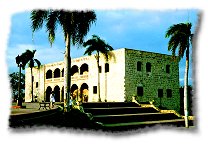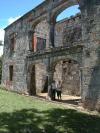|
|
|
|
|
Student
Services offers |
|
THE
COLONIAL ZONE |
ONE-WEEK
TAINO TOUR. All tours start out
in Santo Domingo and its environs and include visits to: Zona
Colonial, Hermanos Guillén ceramics workshop in
Yamasá,San Cristóbal/Cueva Pomiers-Bourbon Santo Cerro and La Vega. here was the very first major battle between Amerindians and Europeans, la Vega Vieja, today a national park. TEN-DAY TAINO TOUR. Altos de Chavón and Isla Saona, Isla Saona, a national park with fabulous beach and a small cave where, supposedly, the Cacique Higueymoto and his family hid out from the Spaniards until he was captured in 1504 TWO-WEEK TAINO. Cotui and the El Hatillo Dam and Reservoir, Visit the incredibly beautiful El Hatillo Dam and Reservoir and the cave called Guácara Taína (by boat) |
--THE COLONIAL ZONE, an
approximately 2-hour walking class to visit all of the most importan t
historical sites in the colonial city with explanations of the Capital’s
Indian, African and Spanish foundations. Optional extras available include
guided tours of the
t
historical sites in the colonial city with explanations of the Capital’s
Indian, African and Spanish foundations. Optional extras available include
guided tours of the  Museo de las Casas Reales (a fabulous museum showcasing objects from the
colonial era as well as Trujillo's collection of arms and armour), Casa de Colón
(or the Alcázar, the fabulous "palace" built by Diego Colón,
Christopher Columbus's older son, when he came to the island as its governor in
1509)), Fortalessa Ozama (an imposing fortress guarding the entrance to the Río
Ozama from the Caribbean), and/or a shopping trip to the Mercado Modelo. Night
tours are also available, when the Colonial Zone turns on its antique lights to
become an even more romantic place than it is during the day.
Museo de las Casas Reales (a fabulous museum showcasing objects from the
colonial era as well as Trujillo's collection of arms and armour), Casa de Colón
(or the Alcázar, the fabulous "palace" built by Diego Colón,
Christopher Columbus's older son, when he came to the island as its governor in
1509)), Fortalessa Ozama (an imposing fortress guarding the entrance to the Río
Ozama from the Caribbean), and/or a shopping trip to the Mercado Modelo. Night
tours are also available, when the Colonial Zone turns on its antique lights to
become an even more romantic place than it is during the day.
 ngo,
a shopping trip to the Mercado Modelo, events and exhibitions at the Dominican
Cultural Plaza (National Theater, Library, Museum of Modern Art, Museum of
History and Geography, Museum of Dominican Man, Natural History Museum), trips
to the river ports of Don Diego and Sans Soucí, and a walking tour of the
famous Malecón, the Capital’s miles-long boulevard that skirts the Caribbean
Sea—on one side of the Malecón are the Capital’s top-rated hotels and
casinos, on the other, a fascinating array of vendors, musicians, bars and
restaurants, foreigners, Dominican families, panhandlers and other colorful
locals who like to stroll along or hang out along the Malecón.
Up
s a 1 to 2-hour class on the island’s indigenous history a
ngo,
a shopping trip to the Mercado Modelo, events and exhibitions at the Dominican
Cultural Plaza (National Theater, Library, Museum of Modern Art, Museum of
History and Geography, Museum of Dominican Man, Natural History Museum), trips
to the river ports of Don Diego and Sans Soucí, and a walking tour of the
famous Malecón, the Capital’s miles-long boulevard that skirts the Caribbean
Sea—on one side of the Malecón are the Capital’s top-rated hotels and
casinos, on the other, a fascinating array of vendors, musicians, bars and
restaurants, foreigners, Dominican families, panhandlers and other colorful
locals who like to stroll along or hang out along the Malecón.
Up
s a 1 to 2-hour class on the island’s indigenous history a nd
culture, followed by a 1-hour tour of the Taíno artifacts in the Museum of
Dominican Man or the private museum, Fundación García-Arévalo. A second class
dedicated to Taíno art is available (half day) to the mountain-top ceramics
workshop of the Guillén Brothers in Yamasá (once a thriving Taíno site),
where authentic replicas of Taíno artifacts are made and sold.
, in addition to the trip to
the ceramics workshop of the Guillén Brothers described above, include trips
to:
Up
nd
culture, followed by a 1-hour tour of the Taíno artifacts in the Museum of
Dominican Man or the private museum, Fundación García-Arévalo. A second class
dedicated to Taíno art is available (half day) to the mountain-top ceramics
workshop of the Guillén Brothers in Yamasá (once a thriving Taíno site),
where authentic replicas of Taíno artifacts are made and sold.
, in addition to the trip to
the ceramics workshop of the Guillén Brothers described above, include trips
to:
Up
La Caleta, an ancient Taíno burial grounds just outside the Capital (wear your swimsuits, for this site is adjacent to a magnificent Caribbean beach).
Cue va
de Pommiers or Cueva de las Maravillas. These two
incredible caves were Taíno ritual centers. Both are filled with fascinating Taíno
drawings, beautiful stalactites and stalagmites, and both are approximately
a 1-hour drive away from the Capital, though in opposite directions.
va
de Pommiers or Cueva de las Maravillas. These two
incredible caves were Taíno ritual centers. Both are filled with fascinating Taíno
drawings, beautiful stalactites and stalagmites, and both are approximately
a 1-hour drive away from the Capital, though in opposite directions.
Río Chacuey, where we’ll wade up the river to discover for ourselves some of the island’s most famous petroglyphs (Taíno art carved into rocks) and swim in the freshwater "charcos" where the Indians once swam before participating in their communal dances. This trip includes a visit to a cassabe factory, where Dominicans still make the traditional "bread" that the Taínos made from yucca. Up
--PUTTING THE "COLOR" IN COLORFUL
is a 1 to 1.5-hour class on the history of African slavery and Afro-Dominican culture, followed by a 1-hour tour of the Museo del Carnaval run by Indefolk and dedicated to the memory of the renowned Afro-Dominican scholar Fradique Lizardo. Optional Show Folklórico Dominicano featuring Afro-Dominican dance and music traditions is available Up--THE COLUMBIAN EXCHANGE
is a 1 to 1.5-hour class that provides an overview of the exchanges of foods, animals, diseases and peoples that have taken place between the Old World and the New World since 1492 and how these exchanges have affected the modern world. Optional buffet of unusual tropical fruits and other Dominican foodstuffs, or a tour of the port area, where so many of the exchanges took place, which incudes a visit to the Museo de las Atarazanas (the "shipwreck" museum). starts with a walk along the Malecón, the broad avenue that runs along the Caribbean Sea the entire length of the Capital. We’ll dance in the open air of historic Playa Güibia with Dominicans both young and old, then move on to one of the most unique nightclubs in the world, the Guácara Taína, which is inside a huge natural cavern 100’ below Santo Domingo’s Parque Mirador del Sur. Not tired yet? Many of the capital’s nightclubs are still packed with dancers until dawn. Let’s join ‘em! Up--TOPS IN TOURISM
is a 1-hour introduction to and history of the Dominican Republic’s number one industry. Includes current tourism statistics, problems, and future potential. Then we’ll tour one or more of the Capital’s most prominent tourist hotels and casinos. Optional day passes, 24-hour, or weekend stays are available of a wide variety of Caribbean beach resorts, most of which provide unlimited food and beverage service, water sports, pool and beach facilities--and something special for us, guided tours of all the resort's functional and administrative areas. A multiple-day tour to compare the island’s various top-ranked resorts is also available.--ALTOS DE CHAVON & CASA DE CAMPO. A popular destination, which is a half-day to full-day tour in and of itself, is the tour of the world-famous Casa de Campo resort and its Altos de Chavón artisan complex and Taíno museum, about two hours east of the Capital, in La Romana. Altos de Chavón is a replica of a medieval Italian villa, with a breathtaking view of the Chavón River far below. We can lunch with the elite at Casa de Campo and enjoy its luxury pools and magnificent Caribbean beaches. Up
--SUGAR
IS NOT ALWAYS SWEET is a 1-hour class that covers the history of
America’s sugar  industry—and accompanying slavery system--which began here on the island of
Hispaniola between 1505 and 1515. Optional tours available include the remains
of several of the island’s 16th-century sugarcane ingenios
and/or a visit to a batey, where the cane workers live and work today,
where (depending upon the season) we’ll see how sugar is grown, harvested and
processed.
Up
industry—and accompanying slavery system--which began here on the island of
Hispaniola between 1505 and 1515. Optional tours available include the remains
of several of the island’s 16th-century sugarcane ingenios
and/or a visit to a batey, where the cane workers live and work today,
where (depending upon the season) we’ll see how sugar is grown, harvested and
processed.
Up
--TROPICAL FRUITS
is a 1-hour class about tropical agriculture. A variety of illustrative tours are available, ranging from a visit to the Capital’s award-winning Botanical Gardens, to market tours or excursions to the island’s small fincas, and large agricultural complexes and multi-national experimental farms.--WHALE
WATCHING IN SAMANA BAY/BOAT TOUR OF LOS HAITISES PARK .
.
--FEEDING THE IGUANAS & CROCODILES AT LAGO ENRIQUILLO.
The drive out to Lago Enriquillo from the Capital is an adventure by itself. The route winds along Caribbean beaches, through sleepy villages, up into the south-central mountain chain, and through sere desert terrain with unbelievable splashes of color, for even here there are flowers. Lago Enriquillo is a vast salt lake with some of the most unusual flora and fauna on the island: bright pink flamingos, ugly but kindly iguanas (they’re vegetarians, you know), crocodiles, turtles, and a wide variety of both sea and land birds. In the center of the lake is Isla Cabritas, which is a national park and crocodile nursery. is a 1 to 1.5-hour class on how the problems between the two republics that share the island of Hispaniola began, and how and why the enmity continues today. Optional excursions to the border towns of Dajabón (and to the Haitian market there) or Jimaní (at the western end of Lago Enriquillo) are available, or we could visit Haitian art galleries and/or cultural associations right here in the Capital. Up--ECONOMICS IN A DEVELOPING WORLD
is a 1 1/2-hour class on the island’s economic ups and downs, tracing the $$$ paths from gold mining, through sugar to tobacco and ranching, chocolate and coffee, to the modern focus on Zonas Francas (free-trade zones), tourism, and communications, along with continuing agricultural efforts. Class is followed by a walking tour to explore the formal and informal methods of vending and merchandising that create such a colorful panorama in developing worlds like the Dominican Republic. Optional tours to any of the nearby Zonas Francas can be arranged, or trips to visit modern sugar mills, cigarette and cigar factories, organic chocolate farms and processing facilities, etc.Up--CARNAVAL, FIESTAS PATRONALES, & THE PROTECTING VIRGINS
. February is Carnival month in the Dominican Republic, a double celebration of pre-Lent
and Independence (February 27). Join us for a 1 ½-hour class on the genesis and
evolution of Dominican Carnaval and the most important of the country’s
patron saints’ festivals, including those of the Virgin de las Mercedes and
the Virgin de Altagracia. If you're here in February, we can go participate in
one or more of the country’s most popular Carnaval celebrations: La Vega,
Puerto Plata and Santo Domingo. Can’t come in February? Easter Week (Semana
Santa) is almost as fun and colorful, as is Corpus Christi. And there are
regional fiestas patronales throughout the year, feast days dedicated to
the various patron saints, each with its own unique and colorful music, dances,
clothes, foods and beverages—among the most celebrated are the feast days of
St. Anthony on June 10, of St. John the Baptist on June 24, and of the Virgin de
Altagracia on January 21. Or we can see a Show Folklórico Dominicano featuring
carnivalesque music & dance. And the end of July is the big Merengue
Festival.... There’s always something to celebrate in the Dominican Republic!Up
is Carnival month in the Dominican Republic, a double celebration of pre-Lent
and Independence (February 27). Join us for a 1 ½-hour class on the genesis and
evolution of Dominican Carnaval and the most important of the country’s
patron saints’ festivals, including those of the Virgin de las Mercedes and
the Virgin de Altagracia. If you're here in February, we can go participate in
one or more of the country’s most popular Carnaval celebrations: La Vega,
Puerto Plata and Santo Domingo. Can’t come in February? Easter Week (Semana
Santa) is almost as fun and colorful, as is Corpus Christi. And there are
regional fiestas patronales throughout the year, feast days dedicated to
the various patron saints, each with its own unique and colorful music, dances,
clothes, foods and beverages—among the most celebrated are the feast days of
St. Anthony on June 10, of St. John the Baptist on June 24, and of the Virgin de
Altagracia on January 21. Or we can see a Show Folklórico Dominicano featuring
carnivalesque music & dance. And the end of July is the big Merengue
Festival.... There’s always something to celebrate in the Dominican Republic!Up
All of the classes and their related tours and excursions can be modified to meet the needs of your particular group.
DETAILS OF OUR MOST POPULAR
CLASSES & TOURS Up
Available in English or in Spanish--other languages on special request.)